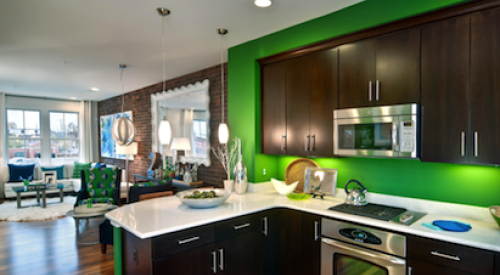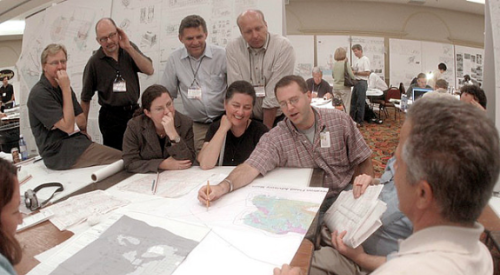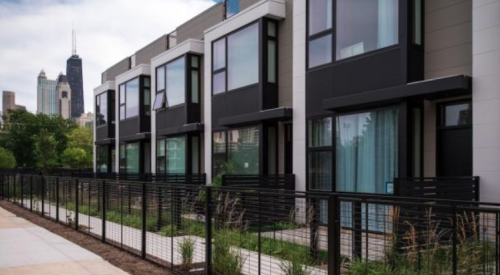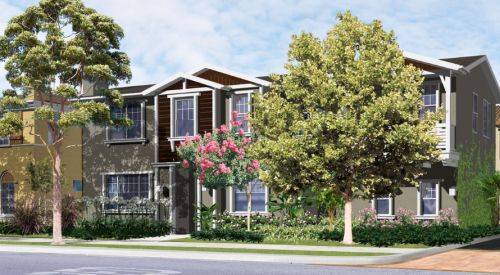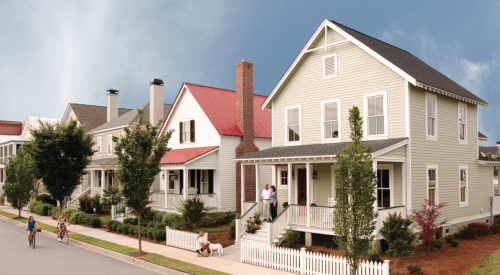|
|
| Shown here is the exterior of 850 West Adams in Chicago and an interior of the 2-D unit, which served as a model home for much of the time the building was on the market. The two-bedroom, 2100-square foot plan sold for $450,000.
|
Those irrepressible baby boomers are at it again. Just when you think they don’t matter anymore, they unleash another global mindset shift that starts a consumer product revolution. It happened with hula hoops in the Fifties and Mustangs in the Sixties. Who would guess that in mid-life crises, instead of buying Porches, boomers would choose lofts in the city?
As it turns out, a few people did make that guess, and like those who once marketed hula hoops, New York and Chicago loft developers have bank accounts that look pretty good today. But take heart: in much of the country, there’s still time to catch the infill housing revolution in its infancy.
|
|
| Cedar shingled, 2083-square foot Plan 4 is one of Classic Communities’ premier homes in Burgess Park. The rear-loaded home sold for $850,000.
|
And it’s not just downtown loft conversions of old warehouse buildings. It’s also townhouses or high-density detached housing in the heart of old established suburbs-the ones with lots of restaurants, boutiques, and coffee shops on walkable streets. It can even be neotraditional projects attached to historic neighborhoods.
Even blighted industrial sites can work if the right attractions are close by. The surprising aspect of this burgeoning boom in infill housing is that getting close to work doesn’t seem to be as important as getting close to the fun.
"A lot of our buyers are actually reverse commuting to jobs or businesses in the suburbs," says pioneer Chicago loft developer Lewis Kostiner. "Fifteen years ago, you couldn’t have paid people to move to downtown Chicago. But now, we’re even converting old class-b office buildings to residential use. Chicago now has about 5000 residential units on the market downtown."
|
|
| Shown here are street scenes in the Village at Port Royal, including the 1-1/2-story Heyward model, an 1800-square foot home that sold this year for $130,950, and the Barnwell plan, a 1456-square foot 2-story home that sold for $132,086.
|
"My buyers are not the young urban professionals who started the loft conversion business in New York and Chicago," says Kostiner. "What I get are affluent empty-nesters who are tired of constantly driving into the city for entertainment. The kids are gone, and the suburbs are more congested than the city. They ask, ‘Why am I living out here, when downtown is where I want to be?’"
Denver land planner David Clinger is one of them, even though much of his own business revolves around designing golf course communities. After years of living on Lookout Mountain in Golden, Clinger now lives in south Denver’s Cherry Creek neighborhood, a mecca of gentrified infill redevelopment, where 1950s bungalows are being torn down and replaced with townhouses that sell for $1 million or more. "I reverse commute," says Clinger. "It’s not as bad with most of the traffic going the other way. But the best part is getting home and knowing I can go out that evening without getting in a car."
"The school quality issue drove the migration to the suburbs," says Clinger. "When kids and schools are no longer part of the equation, we shouldn’t be surprised that people want to go back to the city. Cities have a lot to offer, and people get bored sitting out there in the suburbs watching the grass grow."
While Chicago and Denver have market-driven infill booms, Seattle and Portland have a different breed. "We have state-mandated growth controls," says Seattle architect William Kreager, "where suddenly there’s a line on the map that you can’t develop beyond. Urban growth boundaries make infill a necessity dictated by government. We’re now seeing a lot of redevelopment downtown and in old neighborhoods, as well as new development in pieces of suburbia that were originally passed-over."
"Seattle will now allow four or even five floors of frame construction, and we’re seeing that. North of the border in Canada, Vancouver is now a real pioneer in creative approaches to rezoning urban and even suburban neighborhoods to allow increased densities. They’ve quadrupled densities in some of those neighborhoods," Kreager notes.
A Different Business
Infill offers huge opportunities, but also enormous risks. It is a very different business from building detached homes at four units to the acre on former agricultural land. Because it is so different, doing infill with the same company and same people who build production subdivisions seems to add another element of risk that may be one too many. The best practitioners in the infill business are specialists.
Finding sites that make sense is not easy, even for specialists. "We do everything imaginable," says Chicago townhouse builder David Dubin, "including scanning the classified pages of the newspapers, driving around neighborhoods, and knocking on doors." Dubin finds churches with congregations that have outgrown their sites to be good sources of residential land. He put 54 townhouses on one site purchased from the Chicago Archdiocese, and 12 condominiums on a former Presbyterian property.
What factors make a site good? "You want to be near public transportation, shopping, and in an established residential neighborhood," says Dubin. "Major expressways are important, because people want to use their cars less, but they don’t intend to give them up. But if you find a site that meets all these criteria, you’re probably looking at a hefty price tag. A location that doesn’t have all of that may be better, if you can get a lower price and pioneer upgraded land use."
Local politics play a huge role in the value of land and the builder’s ability to bring it to market. Builders must deal not only with zoning issues and the agendas of local politicians and planners, but also tiptoe through a minefield of special interest groups and neighboring home owners’ associations. Many builders who specialize in infill often identify someone within the community with knowledge in all these areas, then add that person to their payroll as a consultant on the project.
Specialists in infill also spend much more time and money than the average suburban builder on researching what product to propose for a site, then presenting the concepts to neighbors and special interest groups in private--to build a consensus behind the project--before it ever goes to public hearings.
The most important factor of all, says Clinger, is architecture. "Even more than land planning. You’ve got to design spaces that really sing. None of these deals make sense without raising the density, but you have to do that without compromising privacy. You have to bring light into the spaces without placing windows where they look into the neighbor’s house or yard. You’ve got to choose an architectural look that excites people-something they think will enhance their property values, even though you’re adding density to the neighborhood.This is not easy, and you’d better not count on a designer of production-built detached homes to do it."
Clinger believes infill projects are actually easier to get approved than many of the proposals he presents in suburbia. "The NIMBY (Not In My Backyard) types who don’t want anything built are tougher than what you face in infill. Most infill sites are zoned for a use the neighbors don’t want, or at a higher density than what is proposed. Even at eight units to the acre, detached homes are likely to be well received by neighbors who fear rental apartments at 30 units per acre."
If you decide to jump into this business, you may be well-advised to do upfront what Chicago builder Mickey Sanderman had to do out of necessity several years after jumping into the downtown Chicago market-give up suburban building altogether.
Sanderman is closing his sale of publicly-traded Sundance Homes, with 23 suburban communities in various stages of development, but he will keep the Chicago Urban Properties division that took up much of his time over the past several years.
"It’s a fascinating business," says Sanderman, "The opportunities are there. Wherever you see old houses that have been converted to commercial uses--like doctors’ offices or retail shops--you’re looking at a neighborhood in transition, with the potential for residential redevelopment. But the easy deals are all done in Chicago now. This city’s downtown housing boom is mature. You’re going to have to work to find deals now."
Lewis Kostiner is equally pessimistic about finding new infill opportunities in downtown Chicago and many other urban neighborhoods. "This boom has been going on for five years. With what you have to pay for land now, it’s hard to get any return on equity in residential. It’s impossible in rental apartments. There are still buildings for lofts (conversion), but mostly to the west and north. Around downtown, they’re all gone. Five years ago, you could have bought buildings in my neighborhood for $9 to $12 a square foot. Now, they’re $40 a foot. In Lincoln Park, if you find a lot, it’s going to cost you $500,000 for 25 2 150 feet. By the time you’re done, a new house in Lincoln Park will now be worth $3 million," says Kostiner.
The good news is that other cities don’t have the same maturity of market dynamics-for loft conversions of old warehouses and light manufacturing plants, and for other forms of infill development close to restaurants, nightlife, and other urban attractions. Kostiner urges builders from around the country to visit Chicago and check out what is happening.
After all, the baby boomers in Cincinnati and Rochester are probably ready to party.
Also See:
Chicago Lofts Pull Affluent Baby Boomers
Silicon Valley Infill Is A Classic
South Carolina Neotraditionals Spur Town's Renaissance
